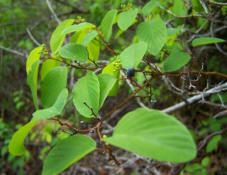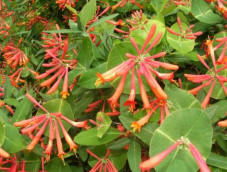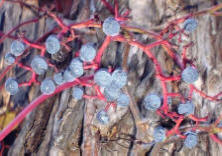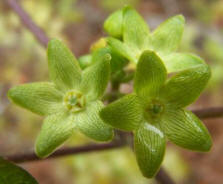
Jan 6, 2017 | Native Vines, VITACEAE - Grape Family
Virginia creeper – Parthenocissus quinquefolia
Virginia creeper grows up into trees & makes an interesting focal point along the trunk of a tree. In the fall, they turn brilliant fall colors & put out bluish fruit. This beautiful native vine is a good substitution for Boston Ivy or other non-native, aggressive vines in landscapes.

Jan 6, 2017 | Native Vines, RHAMNACEAE - Buckthorn Family
Rattanvine – Berchemia scandens
This vine can climb high & it twines, giving it its name “rattan.” It can even become a twining vine-shrub. It is found in thickets or woods, near stream bottoms & slopes. The leaves are reminiscent of Carolina buckthorn leaves, which is in the same family. It produces bluish fruit that stands in contrast against the bright green leaves.

Jan 6, 2017 | MENISPERMACEAE - Moonseed Family, Native Vines
Carolina snailseed – Cocculus carolinus
You may find this vigorous vine growing in your lawn, & you can definitely find it in pastures & other sunny locations. It will climb a fence & completely cover it. So if you need to hide an ugly fence, this is the vine for you! The birds like the fruit of the snailseed too!

Jan 6, 2017 | CAPRIFOLIACEAE - Honeysuckle Family, Native Vines
Coral honeysuckle – Lonicera sempervirens
This beautiful drought-tolerant honeysuckle is a favorite of hummingbirds. It is filled with flowers that stand just above oval fused terminal leaves. It makes a nice background interest on a fence or in a corner. The vine is well-mannered & does not take over like some other vines. It is also sometimes called Evergreen honeysuckle because it doesn’t lose its leaves in the winter.

Jan 6, 2017 | ASCLEPIADACEAE - Milkweed Family, Native Vines
Pearl milkvine – Matelea reticulata
This delicate vine is often overlooked on a hike through the woods; although it can climb up to 12′ into a tree! The unassuming star-shaped green flowers have reticulate veins & pearly stamen column. The heart-shaped leaves would create an additional interest in a landscape setting.







